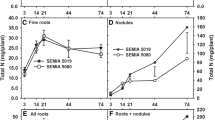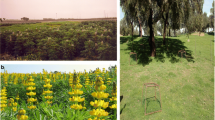Abstract
Quantifying below-ground nitrogen (N) of legumes is fundamental to understanding their effects on soil mineral N fertility and on the N economies of following or companion crops in legume-based rotations. Methodologies based on 15N shoot-labelling with subsequent measurement of 15N in recovered plant parts (shoots and roots) and in the root-zone soil have proved promising. We report four glasshouse experiments with objectives to develop appropriate protocols for in situ 15N labelling of the four legumes, fababean (Vicia faba), chickpea (Cicer arietinum), mungbean (Vigna radiata) and pigeonpea (Cajanus cajan). Treatments included 15N-urea concentration (0.1–2.0% w/w), feeding technique (leaf-flap and petiole), leaflet/petiole position (top and bottom of shoot) and frequency of feeding (one and two occasions). 15N-labelling via the leaf-flap was best for fababean, mungbean and pigeonpea, whilst petiole feeding was best for chickpea, in all cases at the lower-stem nodes 3 or 4 using 0.2 mL volumes of 0.5% urea (98 atom% 15N excess). Fed leaflets and petioles were removed within 2 weeks of labelling. Uneven 15N enrichment of the nodulated roots because of effects of the less-enriched nodules meant that root derived N in soil would be overestimated if recovered roots were more heavily nodulated than unrecovered roots. One possible solution would be to assume crown nodulation of the plants. Thus, recovered roots would be nodulated; root-derived N remaining in soil may be without nodules. The ratios of nodulated root to unnodulated root enrichments could then be used as an adjustment in the calculations, i.e. in the case of fababean and chickpea, by dividing calculated root-derived N in soil by 1.12 (fababean) and 1.56 (chickpea).
Similar content being viewed by others
References
Evans J, O'Connor G E, Turner G L, Coventry D R, Fettell N, Mahoney J, Armstrong E L and Walsgott D N 1989 N2 fixation and its value to soil N increases in lupin, field pea and other legumes in south-eastern Australia. Aust. J. Agric. Res. 40, 791-805.
Herridge D F 1982 Relative abundance of ureides and nitrate in plant tissues of soybean as a quantitative assay of nitrogen fixation. Plant Physiol. 70, 1-6.
Janzen H H and Bruinsma Y 1989 Methodology for the quantification of root and rhizosphere nitrogen dynamics by exposure of shoots to 15N-labelled ammonia. Soil Biol. Biochem. 21, 189-196.
Jensen E S 1996a Rhizodeposition of N by pea and barley and its effect on soil N dynamics. Soil Biol. Biochem. 28, 65-71.
Jensen E S 1996b Barley uptake of N deposited in the rhizosphere of associated field pea. Soil Biol. Biochem. 28, 159-168.
McNeill A M, Hood R C and Wood M 1994 Direct measurement of nitrogen fixation by Trifolium repens L. and Alnus glutinosa L. using 15N2. J. Exp. Bot. 45, 749-755.
McNeill A M, Zhu C and Fillery I R P 1997 Use of in situ 15Nlabelling to estimate the total below-ground nitrogen of pasture legumes in intact soil-plant systems. Aust. J. Agric. Res. 48, 295-304.
McNeill A M, Zhu C and Fillery I R P 1998 A new approach to quantifying the N benefit from pasture legumes to succeeding wheat. Aust. J. Agric. Res. 49, 427-436.
Palta J A, Fillery I R P, Mathews E L and Turner N C 1991 Leaf feeding of [15N] urea for labelling wheat with nitrogen. Aust. J. Plant Physiol. 18, 627-636.
Pate J S, Peoples M B and Atkins C A 1983 Post-anthesis economy of carbon in a cultivar of cowpea. J. Exp. Bot. 34, 544-562.
Pate J S, Peoples M B and Atkins C A 1984 Spontaneous phloem bleeding from cryopunctured fruits of a ureide-producing legume. Plant Physiol. 74, 499-505.
Rochester I J, Peoples M B, Constable G A and Gault R R 1998 Faba beans and other legumes add nitrogen to irrigated cotton cropping systems. Aust. J. Exp. Agric. 38, 253-260.
Ruschel A P, Salati E and Vose P B 1979 Nitrogen enrichment of soil and plant by Rhizobium phaseoli-Phaseolus vulgaris symbiosis. Plant Soil 51, 425-429.
Russell C A and Fillery I R P 1996a In situ labelling of lupin belowground biomass. Aust. J. Agric. Res. 47, 1035-1046.
Russell C A and Fillery I R P 1996b Estimates of lupin belowground biomass nitrogen, dry matter, and nitrogen turnover to wheat. Aust. J. Agric. Res. 47, 1047-1059.
Sawatsky N and Soper R J 1991 A quantitative measurement of the nitrogen loss from the root system of field peas (Pisum avense L.) grown in the soil. Soil Biol. Biochem. 23, 255-259.
Zebarth B J, Alder V and Sheard R W 1991 In situ labelling of legume residues with a foliar application of a 15N-enriched urea solution. Comm. Soil Sci. Plant Anal. 22, 437-447.




